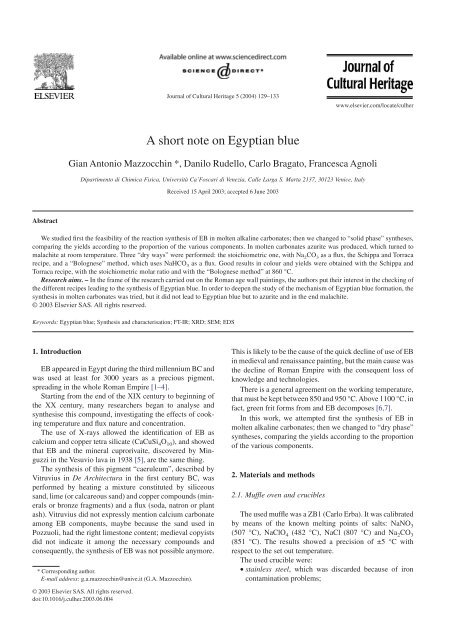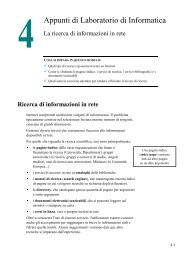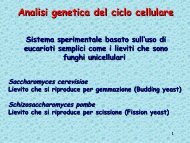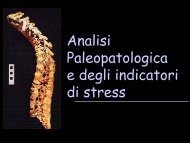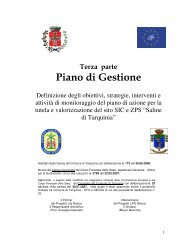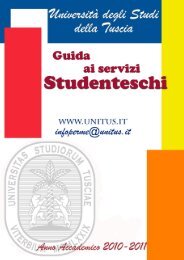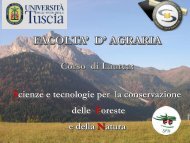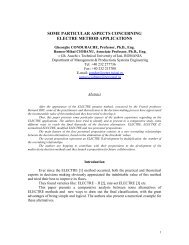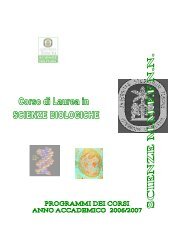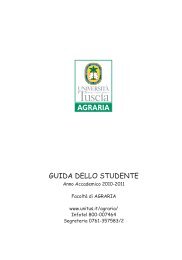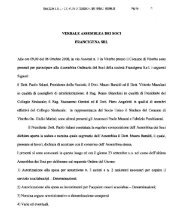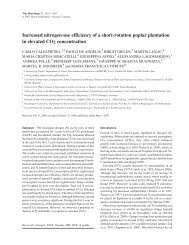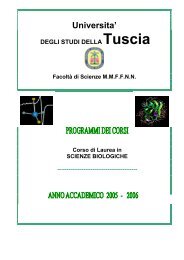A short note on Egyptian blue
A short note on Egyptian blue
A short note on Egyptian blue
You also want an ePaper? Increase the reach of your titles
YUMPU automatically turns print PDFs into web optimized ePapers that Google loves.
Abstract<br />
A <str<strong>on</strong>g>short</str<strong>on</strong>g> <str<strong>on</strong>g>note</str<strong>on</strong>g> <strong>on</strong> <strong>Egyptian</strong> <strong>blue</strong><br />
Gian Ant<strong>on</strong>io Mazzocchin *, Danilo Rudello, Carlo Bragato, Francesca Agnoli<br />
Dipartimento di Chimica Fisica, Università Ca’Foscari di Venezia, Calle Larga S. Marta 2137, 30123 Venice, Italy<br />
Received 15 April 2003; accepted 6 June 2003<br />
We studied first the feasibility of the reacti<strong>on</strong> synthesis of EB in molten alkaline carb<strong>on</strong>ates; then we changed to “solid phase” syntheses,<br />
comparing the yields according to the proporti<strong>on</strong> of the various comp<strong>on</strong>ents. In molten carb<strong>on</strong>ates azurite was produced, which turned to<br />
malachite at room temperature. Three “dry ways” were performed: the stoichiometric <strong>on</strong>e, with Na 2CO 3 as a flux, the Schippa and Torraca<br />
recipe, and a “Bolognese” method, which uses NaHCO 3 as a flux. Good results in colour and yields were obtained with the Schippa and<br />
Torraca recipe, with the stoichiometric molar ratio and with the “Bolognese method” at 860 °C.<br />
Research aims. – In the frame of the research carried out <strong>on</strong> the Roman age wall paintings, the authors put their interest in the checking of<br />
the different recipes leading to the synthesis of <strong>Egyptian</strong> <strong>blue</strong>. In order to deepen the study of the mechanism of <strong>Egyptian</strong> <strong>blue</strong> formati<strong>on</strong>, the<br />
synthesis in molten carb<strong>on</strong>ates was tried, but it did not lead to <strong>Egyptian</strong> <strong>blue</strong> but to azurite and in the end malachite.<br />
© 2003 Elsevier SAS. All rights reserved.<br />
Keywords: <strong>Egyptian</strong> <strong>blue</strong>; Synthesis and characterisati<strong>on</strong>; FT-IR; XRD; SEM; EDS<br />
1. Introducti<strong>on</strong><br />
EB appeared in Egypt during the third millennium BC and<br />
was used at least for 3000 years as a precious pigment,<br />
spreading in the whole Roman Empire [1–4].<br />
Starting from the end of the XIX century to beginning of<br />
the XX century, many researchers began to analyse and<br />
synthesise this compound, investigating the effects of cooking<br />
temperature and flux nature and c<strong>on</strong>centrati<strong>on</strong>.<br />
The use of X-rays allowed the identificati<strong>on</strong> of EB as<br />
calcium and copper tetra silicate (CaCuSi 4O 10), and showed<br />
that EB and the mineral cuprorivaite, discovered by Minguzzi<br />
in the Vesuvio lava in 1938 [5], are the same thing.<br />
The synthesis of this pigment “caeruleum”, described by<br />
Vitruvius in De Architectura in the first century BC, was<br />
performed by heating a mixture c<strong>on</strong>stituted by siliceous<br />
sand, lime (or calcareous sand) and copper compounds (minerals<br />
or br<strong>on</strong>ze fragments) and a flux (soda, natr<strong>on</strong> or plant<br />
ash). Vitruvius did not expressly menti<strong>on</strong> calcium carb<strong>on</strong>ate<br />
am<strong>on</strong>g EB comp<strong>on</strong>ents, maybe because the sand used in<br />
Pozzuoli, had the right limest<strong>on</strong>e c<strong>on</strong>tent; medieval copyists<br />
did not indicate it am<strong>on</strong>g the necessary compounds and<br />
c<strong>on</strong>sequently, the synthesis of EB was not possible anymore.<br />
* Corresp<strong>on</strong>ding author.<br />
E-mail address: g.a.mazzocchin@unive.it (G.A. Mazzocchin).<br />
© 2003 Elsevier SAS. All rights reserved.<br />
doi:10.1016/j.culher.2003.06.004<br />
Journal of Cultural Heritage 5 (2004) 129–133<br />
This is likely to be the cause of the quick decline of use of EB<br />
in medieval and renaissance painting, but the main cause was<br />
the decline of Roman Empire with the c<strong>on</strong>sequent loss of<br />
knowledge and technologies.<br />
There is a general agreement <strong>on</strong> the working temperature,<br />
that must be kept between 850 and 950 °C.Above 1100 °C, in<br />
fact, green frit forms from and EB decomposes [6,7].<br />
In this work, we attempted first the synthesis of EB in<br />
molten alkaline carb<strong>on</strong>ates; then we changed to “dry phase”<br />
syntheses, comparing the yields according to the proporti<strong>on</strong><br />
of the various comp<strong>on</strong>ents.<br />
2. Materials and methods<br />
2.1. Muffle oven and crucibles<br />
www.elsevier.com/locate/culher<br />
The used muffle was a ZB1 (Carlo Erba). It was calibrated<br />
by means of the known melting points of salts: NaNO 3<br />
(507 °C), NaClO 4 (482 °C), NaCl (807 °C) and Na 2CO 3<br />
(851 °C). The results showed a precisi<strong>on</strong> of ±5 °C with<br />
respect to the set out temperature.<br />
The used crucible were:<br />
• stainless steel, which was discarded because of ir<strong>on</strong><br />
c<strong>on</strong>taminati<strong>on</strong> problems;
130 G.A. Mazzocchin et al. / Journal of Cultural Heritage 5 (2004) 129–133<br />
• porcelain, which was discarded because of aluminium<br />
c<strong>on</strong>taminati<strong>on</strong> problems, besides the difficulties in removing<br />
the compound from the walls of the crucible;<br />
• nickel, which presented the same problems of the stainless<br />
steel, even if to a small extent;<br />
• zirc<strong>on</strong>ium, which was acceptable but not resisting<br />
enough: in fact, after some use it weakened and got<br />
punctured;<br />
• terracotta, undoubtedly the best and lowest-cost <strong>on</strong>e.<br />
2.2. Reagents<br />
Chemicals were generally of analytical grade. Libya and<br />
Egypt sands were used in some cases, but the best results<br />
were obtained with finely ground rose quartz.<br />
2.3. Optical microscopy<br />
The samples were observed by means of an optical microscope<br />
Wild-Leitz M8 with a 19.2× to 256× zoom. The<br />
samples were illuminated using a movable fibre glass system.<br />
2.4. Scanning electr<strong>on</strong> microscopy (SEM)<br />
SEM images were taken using a Jeol (Tokyo, Japan) JSM<br />
5600 LV equipped with an Oxford Instruments 6587 EDS<br />
microanalysis detector. The images were taken under low<br />
vacuum c<strong>on</strong>diti<strong>on</strong>s where samples did not show charging<br />
effects; in this way, it was possible to avoid the coating of the<br />
samples with a high c<strong>on</strong>ductance thin film (gold or graphite<br />
films).<br />
EDS microanalysis was made to obtain informati<strong>on</strong> <strong>on</strong> the<br />
elemental compositi<strong>on</strong> of the sample.<br />
2.5. X-ray diffracti<strong>on</strong> (XRD)<br />
X-ray powder diffracti<strong>on</strong> was used to identify the different<br />
crystalline phases present in the pigments. A Philips X’Pert<br />
vertical g<strong>on</strong>iometer with Bragg–Brentano geometry, c<strong>on</strong>nected<br />
to a highly stabilised generator, was used for XRD<br />
analysis. Cu-K a Ni-filtered radiati<strong>on</strong>, a graphite m<strong>on</strong>ochromator<br />
<strong>on</strong> the diffracted beam and a proporti<strong>on</strong>al counter with<br />
pulse height discriminator were used. Measurements in a<br />
5–60° range were taken with a step size of 0.05° and 2°s per<br />
point.<br />
2.6. Infrared spectroscopy (FT-IR)<br />
Absorpti<strong>on</strong> spectra in the IR regi<strong>on</strong> were collected using a<br />
Nicolet Magna 75 FT-IR spectrometer. The spectra were<br />
given as an average of 32 measurements. Samples were<br />
diluted in KBr pellet (IR grade, Merck).<br />
3. Results and discussi<strong>on</strong><br />
The first synthesis attempts were carried out in molten<br />
carb<strong>on</strong>ates at 860 °C.<br />
Twenty grams of Na2CO3 were mixed with 20 g K2CO3 and the mixture transferred in a large zirc<strong>on</strong>ium or porcelain<br />
crucible and put in muffle oven at 860 °C. The molten<br />
mixture was colourless; 2.5 g of CaCO3,2gofCuOand6g of SiO2 were then added to the molten mixture. The molar<br />
ratios of SiO2:CuO:CaO were 4:1:1, as required by the stoichiometry<br />
of the product to be synthesised.<br />
After the additi<strong>on</strong> of CaCO3 the soluti<strong>on</strong> remained<br />
colourless-pale yellow, while after the additi<strong>on</strong> of CuO it<br />
became yellow-green. After SiO2 additi<strong>on</strong>, the liquid began<br />
to bubble because of the formati<strong>on</strong> of CO2 according to the<br />
2– 2–<br />
reacti<strong>on</strong>: CO3 + SiO2 → SiO3 +CO2↑<br />
After 2hinovenmuffle,themolten mixture was poured<br />
<strong>on</strong> a stainless steel plate where we observed beautiful <strong>blue</strong><br />
drops (Fig. 1a). Leaving the product at room temperature, it<br />
absorbed humidity and its colour became green (Fig. 1b)<br />
[8,9].<br />
FT-IR spectra of the <strong>blue</strong> product showed the characteristic<br />
bands of carb<strong>on</strong>ates, while the bands typical of EB,<br />
around 1000–1050 cm –1 Fig. 1. (a) Drop of <strong>blue</strong> obtained by a synthesis carried out in liquid phase of<br />
molten carb<strong>on</strong>ates; (b) the colour of the <strong>blue</strong> product left at room temperature<br />
changed to green.<br />
, shifted to the <strong>on</strong>es of malachite.<br />
We cannot completely exclude also the formati<strong>on</strong> of<br />
amounts of copper silicate and calcium silicate.<br />
Therefore, we began to study the “dry syntheses” mixing<br />
the required amounts of compounds and grinding them to-
Fig. 2. (a) C<strong>on</strong>tent of the crucibles at the end of the reacti<strong>on</strong> carried out<br />
following the recipe by Schippa and Torraca; (b) c<strong>on</strong>tent of the crucibles at<br />
the end of the reacti<strong>on</strong> carried out following the “Bolognese mixture”.<br />
gether in an agate mortar and, then, transferring the mixture<br />
in muffle oven <strong>on</strong> small terracotta plates. When the amount of<br />
Na 2CO 3 flux exceeds the molar ratio 0.5–1, <strong>on</strong>e is allowed to<br />
observe the formati<strong>on</strong> of a semi-solid grey mass, which was<br />
difficult to be removed from the terracotta surface. This did<br />
not allow to take, grind and put the product again in muffle.<br />
Anyway, the terracotta crucibles or plates revealed to be<br />
suitable for the assays carried out at these temperatures.<br />
We repeated some experiences already reported by Bianchetti<br />
et al. [6] which deals with mixtures described by<br />
Hansen and Jensen [11] but the used molar ratios did not<br />
allowed us to get good EB products.<br />
On the c<strong>on</strong>trary, by using stoichiometric ratios (4:1:1), as<br />
suggested by Bruni et al. [12], and adding Na 2CO 3 quantities<br />
to have a 0.5–1 molar ratio range, we obtained better results<br />
in the colour of the product, kept in muffle oven <strong>on</strong>ly for 3 h.<br />
(These results were obtained using the following amounts of<br />
reagents: 6 g of SiO 2, 2.5 g of CaCO 3,2.0gofCuOand2gof<br />
Na 2CO 3 at 860 °C.)<br />
Attempts to use borax or Na 2SO 4 as a flux did not lead to<br />
better results.<br />
The role played by different flux as Li 2CO 3 or K 2CO 3 was<br />
tested and the results were similar to the <strong>on</strong>es obtained using<br />
G.A. Mazzocchin et al. / Journal of Cultural Heritage 5 (2004) 129–133<br />
Fig. 3. FT-IR spectra of the “Bolognese mixture” sample (a), of the stoichiometric<br />
sample (b) and of a Roman EB sample found in Vicenza (c).<br />
Na 2CO 3, being careful that the fusi<strong>on</strong> of the reacti<strong>on</strong> mass<br />
was easier and leading to a dark grey product, which firmly<br />
sticks to the terracotta plate [2–4].<br />
Some assays were carried out to check the effect of the<br />
physical status of SiO 2 using colloidal silica gel following<br />
the recipe by Schippa and Torraca [10], which used molar<br />
ratios of 4.0:1.1:1.0:0.2 (with copper amounts slightly higher<br />
than the stoichiometric <strong>on</strong>es).<br />
In these experiments, we got good quality products taking<br />
care in the repeated grinding of the product and leaving it in<br />
muffle oven for 12 h (Fig. 2a).<br />
In our lab, we also tested a “Bolognese mixture” [13],<br />
characterised by the following molar ratios: 10:1.4:1.4 for<br />
Si:Ca:Cu, respectively, with NaHCO 3 as flux in a molar ratio<br />
of1(Fig. 2b) (typical quantities were: 6.02 g of SiO 2, 1.45 g<br />
of CaCO 3, 1.73 g of malachite, 0.80 g of NaHCO 3).<br />
We used a simple method to evaluate the yield of EB in the<br />
obtained product, from the amount of calcium carb<strong>on</strong>ate<br />
residue.<br />
131
132 G.A. Mazzocchin et al. / Journal of Cultural Heritage 5 (2004) 129–133<br />
Fig. 4. EDS spectra of the “Bolognese mixture” sample (a), of the stoichiometric<br />
sample (b) and of a Roman EB sample found in Vicenza (c).<br />
Thus we were able to verify that the EB obtained using the<br />
recipe by Schippa gave a yield around 90% similar to the<br />
stoichiometric method, while the “Bolognese” gave yield up<br />
to 97%.<br />
The processes of re-treatment, performed in muffle oven,<br />
had a positive effect also for the stoichiometric mixture with<br />
Na2CO3 as a flux, as reported also by Bruni et al. [12].<br />
In Fig. 3, the FT-IR spectra of a Bolognese sample (a), of<br />
a stoichiometric <strong>on</strong>e (b) and of a roman EB sample (c) found<br />
in Vicenza [14] are shown.<br />
As <strong>on</strong>e is allowed to see, the typical bands of EB (medium<br />
intensity bands at 1005 and 1050 cm –1 and low intensity<br />
bands at 1170 and 1240 cm –1 ) are present, but in our products<br />
the carb<strong>on</strong>ate amount is lower (band at 1450 cm –1 ) [15].<br />
In Fig. 4, the EDS spectra of the same three products are<br />
shown: again, calcium amount is higher in the roman sample,<br />
in which a small amount of magnesium is also present. In<br />
Fig. 5, the corresp<strong>on</strong>ding XRD spectra are shown. The similarity<br />
of the spectra c<strong>on</strong>firms that the synthesis product is<br />
cuprorivaite in all cases.<br />
In Fig. 6, the SEM image of a stoichiometric product<br />
heated up to 1100 °C is shown. The resulting product was<br />
green, and showed a rounded molten surface shape due to the<br />
decompositi<strong>on</strong> of EB at high temperatures [6,7].<br />
4. C<strong>on</strong>clusi<strong>on</strong>s<br />
Our tests c<strong>on</strong>firm most of the data already reported by<br />
many authors [2–4]. In fact good yields in EB can be obtained<br />
with stoichiometric calcium, copper and silica ratios,<br />
using Na2CO3 as a flux. The reiterated grinding of the products<br />
had a positive effect, just like as a 12 h permanence in<br />
muffle oven at 850–900 °C. We also c<strong>on</strong>firm the EB decompositi<strong>on</strong><br />
at temperatures higher than 1100 °C, also leading to<br />
the formati<strong>on</strong> of green frit.<br />
As far as the “Bolognese mixture” is c<strong>on</strong>cerned, our tests<br />
c<strong>on</strong>firm that the recipe used by the students of the course<br />
Material Chemistry and ceramics technologies (Faenza) in<br />
the Inorganic Chemistry laboratory gave good yields, even if<br />
the comp<strong>on</strong>ent molar ratios are not the stoichiometric <strong>on</strong>es<br />
[2–4]. NaHCO3 becomes Na2CO3 at temperature higher than<br />
250 °C, while malachite begins to decompose at 300 °C and<br />
all the carb<strong>on</strong>ate decomposes above 650 °C. All these data<br />
seem to suggest that the reacti<strong>on</strong> leading to EB is favoured by<br />
the “fresh preparati<strong>on</strong>” of the oxides reacting <strong>on</strong> the surface<br />
of finely grounded SiO2 [4].<br />
It is also known that silic<strong>on</strong> dioxide c<strong>on</strong>tent in EB varies<br />
from 58.5% to 88.7% [4,16], thus it is not surprising that we<br />
got good yields with SiO2 percentages ranging from 57% to<br />
77%.<br />
FT-IR, EDS and XRD data indicate that the same product<br />
can be obtained either with the stoichiometric and the “Bolognese<br />
method”. On the c<strong>on</strong>trary, the synthesis in molten<br />
carb<strong>on</strong>ates, through the dissoluti<strong>on</strong> of silica and the formati<strong>on</strong><br />
of silicates, did not give any result as EB synthesis is<br />
c<strong>on</strong>cerned.
Fig. 5. XRD spectra of the “Bolognese mixture” sample (a), of the stoichiometric<br />
sample (b) and of a Roman EB sample found in Vicenza (c).<br />
G.A. Mazzocchin et al. / Journal of Cultural Heritage 5 (2004) 129–133<br />
Fig. 6. SEM image of a stoichiometric product heated up to 1100 °C.<br />
References<br />
[1] D. Ullrich, <strong>Egyptian</strong> <strong>blue</strong> and green frit: characterizati<strong>on</strong>, history and<br />
occurence, synthesis, PACT 17 (II.3.1) (1987) 323–332.<br />
[2] F. Delamare, De la compositi<strong>on</strong> du bleu égyptien utilisé en peinture<br />
murale gallo-romaine, Scienze e materiali del patrim<strong>on</strong>io culturale 4<br />
(1998) 177–195.<br />
[3] F. Delamare, Le bleu éegyptien, essai de bibliographie critique, Scienze<br />
e materiali del patrim<strong>on</strong>io culturale 4 (1998) 143–163.<br />
[4] J. Riederer, <strong>Egyptian</strong> <strong>blue</strong>, in: E.W. FitzHugh (Ed.), Artists’Pigments:<br />
a Handbook of their History and Characteristics, vol. 3, Washingt<strong>on</strong>,<br />
Nati<strong>on</strong>al Gallery of Art, 1997, pp. 23–45.<br />
[5] C. Minguzzi, Cuprorivaite: un nuovo minerale, Periodico di Mineralogia<br />
9 (1938) 333.<br />
[6] P. Bianchetti, F. Talarico, M.G. Vigliano, M.F. Ali, Producti<strong>on</strong> and<br />
characterizati<strong>on</strong> of <strong>Egyptian</strong> <strong>blue</strong> and <strong>Egyptian</strong> green frit, Journal of<br />
Cultural Heritage 1 (2000) 179–188.<br />
[7] P. Baraldi, F. B<strong>on</strong>dioli, C. Fagnano, A.M. Ferrari, A. Tinti, M. Vinella,<br />
Study of the vibrati<strong>on</strong>al spectrum of cuprorivaite, Annali di Chimica<br />
91 (2001) 679–692.<br />
[8] J.L. Pérez-Rodrìguez, C. Maqueda, M.C. Jiménez de Haro,<br />
P. Rodrìguez-Rubio, Effect of polluti<strong>on</strong> <strong>on</strong> polychromed ceramic<br />
statues, Atmospheric Envir<strong>on</strong>ment 32 (6) (1998) 993–998.<br />
[9] R.J. Gettens, E. West FitzHugh, Azurite and <strong>blue</strong> verditer, in:<br />
E.W. FitzHugh (Ed.), Artists’Pigments: a Handbook of their History and<br />
Characteristics, vol. 2, Washingt<strong>on</strong>, Nati<strong>on</strong>al Gallery of Art, 1997,<br />
pp. 23–35.<br />
[10] G. Schippa, G. Torraca, C<strong>on</strong>tributo alla c<strong>on</strong>oscenza del Blu egiziano,<br />
Bollettino dell’Istituto Centrale di Restauro 31–32 (1957) 97–107.<br />
[11] F. Hansen, O.I. Jensen, Farkevemi, Unorganiske pigmenter, G.E.C<br />
GAD, Copenhagen, 1991.<br />
[12] S. Bruni, F. Cariati, F. Casadio, L. T<strong>on</strong>iolo, Spectrochemical characterisati<strong>on</strong><br />
by micro-FTIR spectroscopy of <strong>blue</strong> pigments in different<br />
polychrome works of art, Vibrati<strong>on</strong>al Spectroscopy 20 (1999) 15–25.<br />
[13] M.C. Iappalucci, private communicati<strong>on</strong>.<br />
[14] G.A. Mazzocchin, F. Agnoli, I. Colpo, Investigati<strong>on</strong> of Roman age<br />
pigments found <strong>on</strong> pottery fragments, Analytica Chimica Acta 478 (1)<br />
(2003) 147–161.<br />
[15] P. Mirti, L. Appoll<strong>on</strong>ia, A. Casoli, R.P. Ferrari, E. Laurenti, A. Amicano<br />
Canesi, G. Chiari, Spectrochemical and structural studies <strong>on</strong> a<br />
Roman sample of <strong>Egyptian</strong> <strong>blue</strong>, Spectrochimica Acta 51 (3) (1995)<br />
437–446.<br />
[16] M.S. Tite, M. Bins<strong>on</strong>, M.R. Cowell, Technological examinati<strong>on</strong> of<br />
<strong>Egyptian</strong> <strong>blue</strong>, in: J.B. Lambert (Ed.), Archaeological Chemistry, vol.<br />
3, Washingt<strong>on</strong> American Chemical Society, 1984, pp. 215.<br />
133


